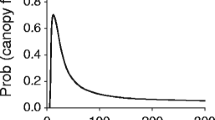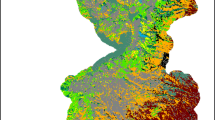Abstract
In the boreal forest, fire, insects, and logging all affect spatial patterns in forest age and species composition. In turn, spatial legacies in age and composition can facilitate or constrain further disturbances and have important consequences for forest spatial structure and sustainability. However, the complex three-way interactions among fire, insects, and logging and their combined effects on forest spatial structure have seldom been investigated. We used a spatially explicit landscape simulation model to examine these interactions. Specifically, we investigated how the amount and the spatial scale of logging (cutblock size) in combination with succession, fire, and spruce budworm outbreaks affect area burned and area defoliated. Simulations included 30 replicates of 300 years for each of 19 different disturbance scenarios. More disturbances increased both the fragmentation and the proportion of coniferous species and imposed additional constraints on the extent of each disturbance. We also found that harvesting legacies affect fire and budworm differently due to differences in forest types consumed by each disturbance. Contrary to expectation, budworm defoliation did not affect area burned at the temporal scales studied and neither amount of logging nor cutblock size influenced defoliation extent. Logging increased fire size through conversion of more of the landscape to early seral, highly flammable forest types. Although logging increased the amount of budworm host species, spruce budworm caused mortality was reduced due to reductions in forest age. In general, we found that spatial legacies do not influence all disturbances equally and the duration of a spatial legacy is limited when multiple disturbances are present. Further information on post-disturbance succession is still needed to refine our understanding of long-term disturbance interactions.








Similar content being viewed by others
References
Baker WL. 1992. The landscape ecology of large disturbances in the design and management of nature reserves. Landscape Ecol 7:181–94.
Bergeron Y, Leduc A. 1998. Relationships between change in fire frequency and mortality due to spruce budworm outbreak in the southeastern Canadian boreal forest. J Veg Sci 9:492–500.
Bergeron Y, Leduc A, Morin H, Joyal C. 1995. Balsam fir mortality following the last spruce budworm outbreak in northwestern Quebec. Can J For Res 25:1375–84.
Bergeron Y, Gauthier S, Kafka V, Lefort P, Lesieur D. 2001. Natural fire frequency for the eastern Canadian boreal forest: consequences for sustainable forestry. Can J For Res 31:384–91.
Blais JR. 1983. Trends in the frequency, extent, and severity of spruce budworm outbreaks in eastern Canada. Can J For Res 13:539–47.
Bouchard M, Pothier D. 2008. Simulations of the effects of changes in mean fire return intervals on balsam fir abundance, and implications for spruce budworm outbreaks. Ecol Model 218:207–18.
Bouchard M, Kneeshaw D, Bergeron Y. 2006. Forest dynamics after successive spruce budworm outbreaks in mixedwood forests. Ecology 87:2319–29.
Campbell EM, MacLean DA, Bergeron Y. 2008. The severity of budworm-caused growth reductions in balsam fir/spruce stands varies with the hardwood content of surrounding forest landscapes. For Sci 54:195–205.
Candau J-N, Fleming R. 2005. Landscape-scale spatial distribution of spruce budworm defoliation in relation to bioclimatic conditions. Can J For Res 35:2218–32.
Candau J-N, Fleming RA, Hopkin A. 1998. Spatiotemporal patterns of large-scale defoliation caused by the spruce budworm in Ontario since 1941. Can J For Res 28:1733–41
Cappuccino N, Lavertu D, Bergeron Y, Régniere J. 1998. Spruce budworm impact, abundance and parasitism rate in a patchy landscape. Oecologia 114:236–42.
Carleton TJ. 2000. Vegetation responses to the managed forest landscape of central and northern Ontario. In: Perera A, Euler D, Thompson I, Eds. Ecology of a managed terrestrial landscape: patterns and processes of forest landscapes in Ontario. Vancouver: UBC Press. p 179–97.
Carleton T, MacLellan P. 1994. Woody vegetation responses to fire versus clear-cutting logging: a comparative survey in the central Canadian boreal forest. Ecoscience 1:141–52.
Cooke BJ, Nealis VG, Regniere J. 2007. Insect defoliators as periodic disturbances in northern forest ecosystems. In: Johnson EA, Miyanishi K, Eds. Plant disturbance ecology—the process and the response. Amsterdam: Elsevier. p 487–525.
Côté P, Tittler R, Messier C, Kneeshaw DD, Fall A, Fortin MJ. 2009. Comparing different forest zoning options for landscape-scale management of the boreal forest: possible benefits of the TRIAD. For Ecol Manag 259:418–27.
Didion M, Fortin M-J, Fall A. 2007. Forest age structure as indicator of boreal forest sustainability under alternative management and fire regimes: a landscape level sensitivity analysis. Ecol Model 200:45–58.
Eveleigh ES, McCann KS, McCarthy PC, Pollock SJ, Lucarotti CJ, Morin B, McDougall GA, Strongman DB, Huber JT, Umbanhowar J, Faria LDB. 2007. Fluctuations in density of an outbreak species drive diversity cascades in food webs. Proc Natl Acad Sci 104:16976–81.
Fahrig L. 2003. Effects of habitat fragmentation on biodiversity. Annu Rev Ecol Evol Syst 34:487–515.
Fall A, Fall J. 2001. A domain specific language for models of landscape dynamics. Ecol Model 141:1–18.
Fall A, Fortin M-J, Kneeshaw DD, Yamasaki SH, Messier C, Bouthillier L, Smith C. 2004. Consequences of various landscape-scale ecosystem management strategies and fire cycles on age-class structure and harvest in boreal forests. Can J For Res 34:310–22.
Fleming R. 2000. Climate change and insect disturbance regimes in Canada’s boreal forests. World Resour Rev 12:520–54.
Fleming R, Candau J-N, McAlpine R. 2002. Landscape-scale analysis of interactions between insect defoliation and forest fire in central Canada. Clim Change 55:251–72.
Forestry Canada Fire Danger Group. 1992. Development and structure of the Canadian Forest Fire Behavior Prediction System. Forestry Canada, Ottawa, Ont. Inf. Rep. ST-X-3. 63 p
Foster DR, Knight DH, Franklin JF. 1998. Landscape patterns and legacies resulting from large, infrequent forest disturbances. Ecosystems 1:497–510.
Franklin JF, Forman RTT. 1987. Creating landscape patterns by forest cutting: ecological consequences and principles. Landscape Ecol 1:5–18.
Friedman SK, Reich PB. 2005. Regional legacies of logging: departure from presettlement forest conditions in northern Minnesota. Ecol Appl 15:726–44.
Gray DR, MacKinnon WE. 2006. Outbreak patterns of the spruce budworm and their impacts in Canada. For Chron 82:550–61.
Grimm V, Berger U, Bastiansen F, Eliassen S, Ginot V, Giske J, Goss-Custard J, Grand T, Heinz S, Huse G, Huth A, Jepsen JU, Jørgensen C, Mooij WM, Müller B, Pe’er G, Piou C, Railsback SF, Robbins AM, Robbins MM, Rossmanith E, Rüger N, Strand E, Souissi S, Stillman RA, Vabø R, Visser U, DeAngelis DL. 2006. A standard protocol for describing individual-based and agent-based models. Ecol Model 198:115–26
Gustafson EJ, Shifley SR, Mladenoff DJ, He HS, Nimerfro KK. 2000. Spatial simulation of forest succession and timber harvesting using LANDIS. Can J For Res 30:32–43.
He HS, Mladenoff DJ. 1999. Spatially explicit and stochastic simulation of forest-landscape fire disturbance and succession. Ecology 80:81–99.
Jackson DA. 1993. Stop** rules in principal components analysis: a comparison of heuristical and statistical approaches. Ecology 74:2204–14.
James PMA, Fortin M-J, Fall A, Kneeshaw D, Messier C. 2007. The effects of spatial legacies following shifting management practices and fire on boreal forest age structure. Ecosystems 10:1261–77.
Johnson EA. 1992. Fire and vegetation dynamics: studies from the North American boreal forest. Cambridge: Cambridge University Press.
Knight DH, Wallace LL. 1989. The Yellowstone fires: issues in landscape ecology. Bioscience 39:700–6.
MacLean DA. 1990. Impact of forest pests and fire on stand growth and timber yield: implications for forest management planning. Can J For Res 20:391–404.
MacLean DA, Mackinnon WE. 1997. Effects of stand and site characteristics on susceptibility and vulnerability of balsam fir and spruce to spruce budworm in New Brunswick. Can J For Res 27:1859–71.
Miller A, Rusnock P. 1993. The rise and fall of the silvicultural hypothesis in spruce budworm (Choristoneura fumiferana) management in eastern Canada. For Ecol Manag 61:171–89.
Paine RT, Tegner MJ, Johnson EA. 1998. Compounded perturbations yield ecological surprises. Ecosystems 1:535–45.
Pennanen J, Kuuluvainen T. 2002. A spatial simulation approach to natural forest landscape dynamics in boreal Fennoscandia. For Ecol Manag 164:157–75.
Peres-Neto PR, Jackson DA, Somers KM. 2003. Giving meaningful interpretation to ordination axes: assessing loading significance in principal component analysis. Ecology 84:2347–63.
Peters DPC, Pielke RA, Bestelmeyer BT, Allen CD, Munson-McGee S, Havstad KM. 2004. Cross-scale interactions, nonlinearities, and forecasting catastrophic events. Proc Natl Acad Sci 101:15130–5.
Puettmann KJ, Coates KD, Messier C. 2009. A critique of silviculture: managing for complexity. Washington, DC: Island Press.
R Development Core Team. 2008. R: a language and environment for statistical computing. R Foundation for Statistical Computing, Vienna, Austria. ISBN 3-900051-07-0, http://www.R-Project.org
Radeloff VC, Mladenoff DJ, Boyce MS. 2000. Effects of interacting disturbances on landscape patterns: budworm defoliation and salvage logging. Ecol Appl 10:233–47.
Raffa KF, Aukema BH, Bentz BJ, Carroll AL, Hicke JA, Turner MG, Romme WH. 2008. Cross-scale drivers of natural disturbances prone to anthropogenic amplification: the dynamics of bark beetle eruptions. Bioscience 58:501–17.
Roland J, Taylor PD. 1997. Insect parasitoid species respond to forest structure at different spatial scales. Nature 386:710–13.
Rowe JS. 1972. Forest regions of Canada. Ottawa: Information Canada.
Royama T, MacKinnon WE, Kettela EG, Carter NE, Hartling LK. 2005. Analysis of spruce budworm outbreak cycles in New Brunswick, Canada, since 1952. Ecology 86:1212–24.
Scheller RM, Mladenoff DJ. 2007. An ecological classification of forest landscape simulation models: tools and strategies for understanding broad-scale forested ecosystems. Landscape Ecol 22:491–505.
Schroeder D, Perera AH. 2002. A comparison of large-scale spatial vegetation patterns following clearcuts and fires in Ontario’s boreal forests. For Ecol Manag 159:217–30.
Shugart HH, Leemans R, Bonan GB. 1992. A systems analysis of the boreal forest. Cambridge: Cambridge University Press.
Sougavinski S, Doyon F. 2005. A review of spatial distribution guidelines for the managed Canadian boreal forest. Edmonton, AB: Sustainable Forest Management Network.
Stocks BJ. 1987. Fire potential in the spruce budworm-damaged forests of Ontario. For Chron 63:8–14.
Stocks BJ, Mason JA, Todd JB, Bosch EM, Wotton BM, Amiro BD, Flannigan MD, Hirsch KG, Logan KA, Martell DL, Skinner WR. 2002. Large forest fires in Canada, 1959–1997. J Geophys Res 107:8149
Sturtevant BR, Gustafson EJ, Li W, He HS. 2004. Modeling biological disturbances in LANDIS: a module description and demonstration using spruce budworm. Ecol Model 180:153–74.
Su Q, MacLean DA, Needham TD. 1996. The influence of hardwood content on balsam fir defoliation by spruce budworm. Can J For Res 26:1620–8.
Tang SM, Franklin JF, Montgomery DR. 1997. Forest harvest patterns and landscape disturbance processes. Landscape Ecol 12:349–63.
Turner MG. 1989. Landscape ecology: the effect of pattern on process. Annu Rev Ecol Evol Syst 20:171–97.
Van Wagner CE. 1978. Age-class distribution and the forest fire cycle. Can J For Res 8:220–7
Vasiliauskas S, Chen H. 2002. How long do trees take to reach breast height after fire in northeastern Ontario? Can J For Res 32:1889–92.
Veblen TT, Hadley KS, Nel EM, Kitzberger T, Reid M, Villalba R. 1994. Disturbance regime and disturbance interactions in a Rocky Mountain subalpine forest. J Ecol 82:125–35.
Wallin DO, Swanson FJ, Marks B. 1994. Landscape pattern response to changes in pattern generation rules: land-use legacies in forestry. Ecol Appl 4:569–80.
Acknowledgments
This research was supported by a NSERC-PGS and CFS-NSERC Supplement to PMAJ and a NSERC Discovery grant to MJF and SFMN funding to Kneeshaw and others. Additional financial support for BRS was provided by the US National Fire Plan.
Author information
Authors and Affiliations
Corresponding author
Additional information
Author Contributions
PMAJ designed the study, performed research, analyzed data, contributed new methods, and wrote the paper. MJF designed the study and wrote the paper. BRS designed the study and wrote the paper. AF designed the study, contributed new methods, and wrote the paper. DK designed the study and wrote the paper.
Electronic supplementary material
Below is the link to the electronic supplementary material.
Rights and permissions
About this article
Cite this article
James, P.M.A., Fortin, MJ., Sturtevant, B.R. et al. Modelling Spatial Interactions Among Fire, Spruce Budworm, and Logging in the Boreal Forest. Ecosystems 14, 60–75 (2011). https://doi.org/10.1007/s10021-010-9395-5
Received:
Accepted:
Published:
Issue Date:
DOI: https://doi.org/10.1007/s10021-010-9395-5




